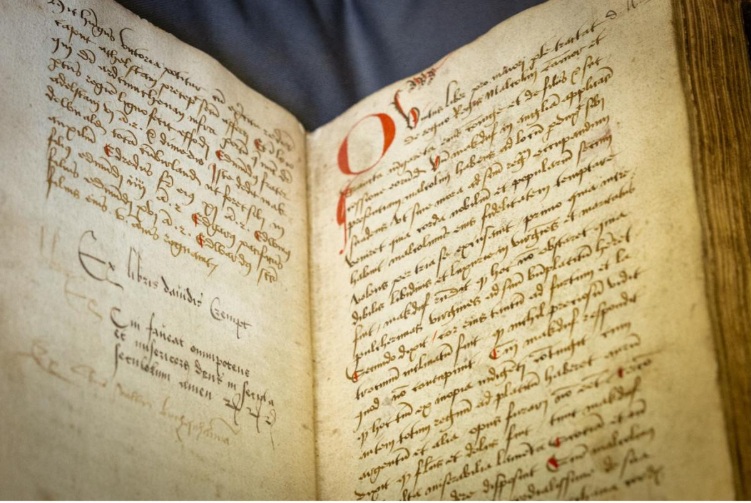Historic manuscript finds a permanent home in Scotland
Published: 7 December 2024
The significance of the manuscript was not known until recent research was carried out on it by a leading UofG historian

Historic manuscript made available to the general public for the first time in 500 years – and finds a permanent home in Scotland.
The St Andrews Chronicles is a startling manuscript. It is largely a handwritten copy of John Mair’s History of Greater Britain – one of the most influential and innovative histories of Scotland and England of the 16th century. However amazingly it also contains an earlier hand-copied pamphlet, chronicling Scotland’s earlier history, including new information about William Wallace, the nation’s time under Guardianship, and even the Stone of Destiny.
The manuscript, which sheds new light on the Scottish Wars of Independence, William Wallace and the Stone of Destiny, was secured for the nation by the Univeristy of St Andrews after being held in a private collection in Norway for 34 years.
It is now available to the public online after being digitised. The significant of the manuscript was not realised until recent research was carried out on it by leading Scottish historian, Professor Dauvit Broun of the University of Glasgow.
Professor Dauvit Broun said: "The contents of this home-made pamphlet include a chronicle for the years 1286 to 1327 which has a few bits of new information (for example, seven - not six - guardians were elected to rule Scotland after Alexander III's tragic death in 1286, as well as Wallace co-leading the attack on the sheriff of Lanark, rather than leading on his own: it also gives us the exact date—3 May 1297—of when this happened). It also has a copy of what is likely to be the earliest version of the legend about the Stone of Destiny.’ quite common as a way of disseminating Scottish history but hardly ever survives."
The book is the size of an iPad and joins the archive and rare book collections at the University of St Andrews. Built up over 600 years, it contains over 200,000 rare books and many medieval and early modern manuscripts. The collection supports teaching and research at the University and elsewhere.
Elizabeth Henderson, Rare Books Librarian at the University of St Andrews, said: “It’s really important that a manuscript like this is held in a public institution like in St Andrews where it can be cared for in perpetuity and can also where it can be made accessible for research.
“It’s a Scottish manuscript about the history of and origins of Scotland, it’s been through a succession of Scottish owners since the 16th century so there’s a real resonance having it back in a Scottish institution.
The manuscript was acquired at auction by the University with generous support from Dr William Zachs and the Friends of the Nations’ Libraries, after being sold by notable Norwegian collector Martin Schoyen, who bought it in 1990. Its own journey is a mystery, but it was at Balcarres in the East Neuk of Fife near St Andrews in the 16th Century.
"I was absolutely delighted that the manuscript has come back to Scotland and particularly to a place with which it has real associations, "said Professor Dame Sally Mapstone, Principal and Vice Chancellor of the University of St Andrews
Sean Rippington, Head of Archives and Rare books at the University of St Andrews, speaking about the manuscript's digitisation, said: "The digital version opens it up to new forms of investigation and research. We wanted to give democratic access for people to see and connect with it. It’s for being read and researched, not for being observed from afar.
"The manuscript has been in private ownership for its entire existence, meaning relatively few people have seen it, so we are keen to make it available to the wider population in as far as possible.”
First published: 7 December 2024

